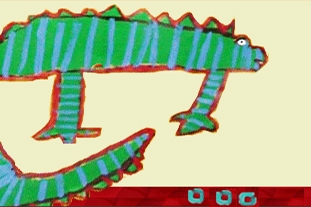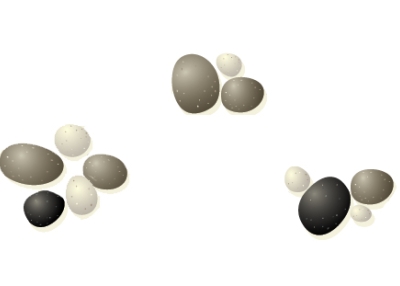Patterns from Nature
Learning about Australia Through Aborigine Art

An art and art appreciation lesson that explores Australia's Aboriginal arts.
Questions
Where is Australia?
Who are the Aborigines? How did their artwork express thier environment and identity?
Objectives/Skills
Using artworks as primary resources to learn about Australia and Aborigines.
Creating artworks based on the inspirations and methods of Aborigines.
Interpretting meaning from artworks (using artworks as primary resources to learn about cultures or places).
Using line, composition, lighting and other art concepts or elements to interpret students' own environments.
Assessment
Teacher can measure student comprehension through quality of discussion (specific questions provided below).
Portfolio assessment is available through the extension activity below.
Procedure
The Aborigines are Australia's original inhabitants, living there for at least 50,000 years. They are hunting and gathering peoples and have developed a detailed knowledge and a great appreciation of their environment, including the plants and animals they depend on for survival. Aborigines feel a deep connection to the natural world, which has shaped every part of their culture. The Aboriginal conceptualization of the natural world has been handed down from generation to generation through the integrated art forms of song, dance, carving, and painting. Art has always played an important role in Aboriginal culture.
Part 1: Picturing Australia through Aborigines' Eyes
Introduce Australia through the eyes of Aborigines. Tell the students a little about the different environments and how we can learn about Australia's peoples and geography through artwork.
On the world map, ask students if anyone knows where Australia is. After pinpointing the continent, show students the Ramingining area, where there are many Aborigines.
Using artworks from The Native Born exhibition,
Larrtha'puy - the Mangroves
Rangipuy - the Beaches
Diltjipuy - the Forests
Retjapuy - the Jungle
Ninydjiya - the Plains
Lead students in a discussion about the artwork, their derived perceptions of Australia, and how they interpret thier own cultures' art or keepsake (in this case, family photographs).
Questions
General questions to motivate observations and personal (or group) interpretation (select one or more images from The Native Born Website):
- What do you see?
- Have you ever seen anything like it? How is it different or the same from other things you have seen?
- What is happening in the work?
Questions that extend the process of observing and interpreting:
- Can you tell how the artist created the work?
- What makes you say that?
- How do you think the work might be used?
- If the work contains shapes, what shapes do you see?
- What information can be concluded regarding history, culture, and/or identity?
Questions that lead to reflection on observations:
- Ask the students what makes them think or say what they do regarding the Aboriginal art.
- Is there something else that brings them to their conclusions?
- What might students learn from thinking about this?
Artists make choices when they create a painting or sculpture. These choices affect the way we read the image. The following are additional questions to pinpoint these choices.
- What information is clear in the picture? What is not so clear?
- How has the artist emphasized certain things? (Size, color, texture, etc.)
After considering each of these elements, consider the following:
- How do each of the above elements affect the way you interpret the picture? What makes you say that?
- What is the subject?
- What did the artist want to convey in this artwork? Did the artist succeed? Why or why not?
- What can we learn about Ramingining, Australia through the artwork?
- How are the student's original perceptions of the artwork been confirmed, altered, or changed through this exercise?
Part 2: Picturing the Land
This activity will help the student make deductions about the importance of the environment to the artists and their community.
Questions
- How do the artwork make you feel?
- What message is the artist trying to communicate?
- Do the works look like they are of Australia? Could they have been created somewhere else?
- Is there something familiar in the artworks?
- Do the artwork communicate something about the environment and its relationship to the Aborigines?
Part 3: Picturing Ourselves
This activity will help students gain an understanding of identity through looking at photographs.
- Ask each student to bring in pictures of his/her own family from different periods of time.
- Ask each student to chose one photograph and write a description of his/her photograph.
- Using the questions Activity 3 to facilitate an analysis, compare and contrast Wang Jingson's photograph entitled "Parents," to the students' photographs.
Questions
- Discuss what the portraits tell us about the students. Identify the family members portrayed. Why were these particular people were chosen? Who is taking the picture? Who is left out of the picture?
- Include the place in which the family has been portrayed. Why was this place was chosen?
- What attitudes and experiences are presented through the details of the people's surroundings?
- What types of events are photographed? Why are these events chosen?
- Think about Wang Jingson's statement, "By presenting them among their possessions, I hope to show not only difference of taste and social status but also the ways in which government policies have marked their lives," while looking at your own photographs. What possessions do you see in your photographs? Why were they chosen to be displayed? Do the possessions say something more about your family?
- Do families put photos into albums? If so, which kinds of pictures are put into the album? Which are not?
- Who in the family puts together the album? Who is the keeper of the family history?
Author: Nancy Blume.
